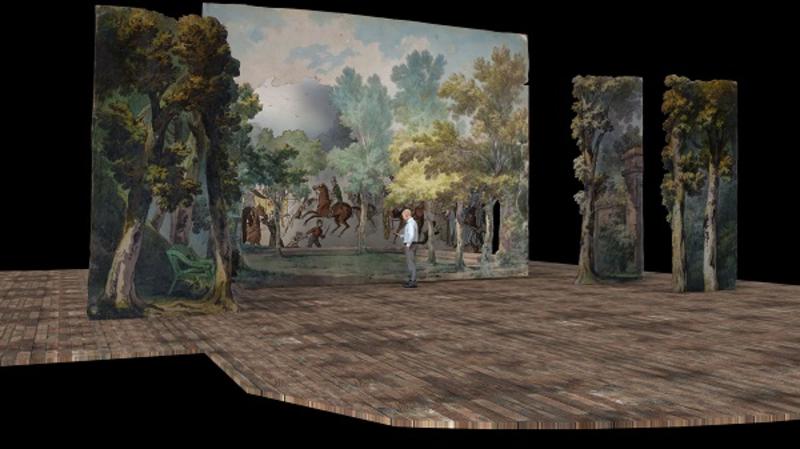Bringing a Sense of Spectacle Back to 18th-Century Pantomime

18th century stage paintings of Kensington Gardens in a virtual stage setting | Image credit Arcade Ltd
We tend to think of special effects as something modern, something that belongs to the age of CGI. But the appeal of spectacle – of media designed to wow us with their immersive, visually breath-taking experiences – goes back centuries. If you lived in London in the eighteenth century, you would know the theatre to be a place of wonder, visual magnificence, and vicarious travel. Plays sought to thrill audiences with elaborate sets, lighting effects, and sometimes even pyrotechnics that transported them back in time or to fantastic or exotic locations.
The problem is that this experience is lost to us. We have scripts, but the most spectacular theatrical forms – such as pantomime – weren’t driven by dialogue. They’re not designed to be read. They were more visual than verbal and the short scripts that come down to us offer only the barest hint of what it must have been like to sit in the playhouse watching them. As someone who researches and teaches 18th-century spectacular theatre, this has long been a source of great frustration.
Out of this frustration has emerged my exciting collaboration with augmented reality specialists Arcade Ltd. Thanks to TORCH Knowledge Exchange Innovation funding, I’ve been able to work with Arcade to bring the look of an eighteenth-century pantomime back to life in digital form. The pantomime in question is Omai, or A Trip Around the World – written by John O’Keeffe, with scenery designed by Philippe Jacques de Loutherbourg, the most pioneering scenographer of his day. It premiered at the Theatre Royal, Covent Garden (on the site of what’s now the Royal Opera House) in December 1785. Then, as now, pantomime was associated especially with Christmas!
The pantomime is very loosely based on the real figure of Omai – or Mai. Mai was a Polynesian islander taken from the South Pacific to London on Captain Cook’s ship as an example of a ‘noble savage’ in 1774. Once in Britain, Mai became both a celebrity and a curiosity. He was presented to King George III and his Queen, Charlotte; he went to the theatre and to the races; and he was painted by the president of the Royal Academy, Sir Joshua Reynolds.
Omai was very much theatre for an age of empire, for an age in which Britain became increasingly confident in its sense of cultural and racial superiority. Theatre was a key site in which Britons were imagining the world beyond their shores – and imagining their nation to be at the very centre of that world. We know that the sets and costumes of Omai aimed to be geographically and ethnographically accurate. Many were copied from the drawings of John Webber, one of the artists Cook took on his third voyage; Webber even seems to have been consulted about specific set designs.
Unusually, three of de Loutherbourg’s set models for the play survive in the archives at the Victoria and Albert Museum. These were the starting point for my collaboration with Arcade. What if we could take these tiny, fragile objects and digitally scale them up? What if we could find a way to let people experience the sets up close and at actual size? What if we could use twenty-first-century spectacular technology (augmented reality) to give us a more vivid and immersive sense of eighteenth-century spectacle? Our aim, in this initial phase of the project for which we have funding, is to produce a test-version of an AR smartphone app that offers viewers the chance to walk into these sets at actual scale. The viewer simply opens the app in a large space and they find themselves on the Covent Garden stage in 1785, with de Loutherbourg’s remarkable scenery in situ.
As a researcher, the challenge for me has been to understand the practicalities of eighteenth-century staging and scenography at the most detailed level possible. The project confronted me with just how much I didn’t know about eighteenth century theatre. I’ve had to think about the exact dimensions of the Covent Garden stage at the time, about the precise arrangement and spacing of the various scenic components, about the way the scenes would be lit, and about what the mechanisms allowing scenery to be moved on and off stage would have been and looked like. All of this has anchored my largely conceptual take on spectacular theatre in the material spaces and technologies of eighteenth-century theatre production. Helping Arcade to ‘build’ a stage and set has transformed the sense I have of the period’s theatre and theatrical practices just as much as the experience of being wander through de Loutherbourg’s extraordinary sets at the press of a button.
Going forward, our aim is to be able to share this experience with as many people as possible. The app, along with walk-through videos of the digitally reconstructed sets, will make teaching and researching eighteenth-century drama a different proposition. It will invite students and scholars to think in new ways about the visual life of eighteenth-century theatre. And the app offers something of huge potential for the heritage sector at large, too. Omai promised to take theatregoers around the world without them having to leave the playhouse. Now the principles and tech behind the app we’re developing promise to let the spectators of today travel into the past and immerse themselves in historic sites and spaces that have long been lost – all simply by taking their phones from their pockets. De Loutherbourg would, I think, have approved.


